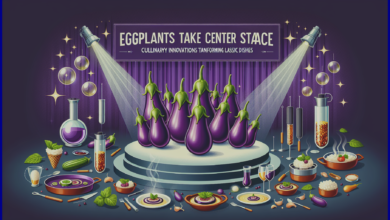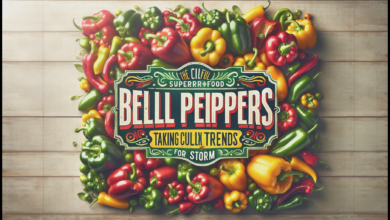Uncovering the Superfood: The Health Benefits, Culinary Uses, and Sustainable Farming of Broccoli

Introduction
Ah, broccoli! Just the sight of those vibrant green florets can evoke a swirl of emotions. Whether you love it or loathe it, there’s no denying this cruciferous vegetable’s prominence in kitchens all around the United States. With its availability year-round, broccoli stands as a beacon of nutritional prowess and culinary versatility. But why is it that health enthusiasts and gourmet chefs alike have raised this vegetable to superfood status? It isn’t just a side dish anymore; it’s an integral part of a balanced, health-conscious lifestyle.
Description
This leafy marvel traces its roots back to the Mediterranean, where it has been cultivated for over two millennia. Characterized by its dense clusters of green flower buds and thick stalks, broccoli comes in various varieties, including the popular Calabrese, purple sprouting, and romanesco, each with its distinct taste and texture. Usually harvested in cooler months, this vegetable thrives in the temperate climate of the U.S., particularly in California where it is grown extensively.
But here’s something fascinating: the name “broccoli” comes from the Italian word "broccolo," meaning the flowering top of a cabbage. And in terms of cultural significance, it has crossed oceans and generations, from ancient Roman tables to modern healthy diets.
Health Benefits
Beneath its crunchy exterior lies a powerful arsenal of nutrients. Broccoli is laden with vitamins C and K, along with fiber, iron, potassium, and a bouquet of antioxidants. It’s no wonder that experts praise this green powerhouse for its role in promoting heart health, aiding digestion, and even supporting weight loss.
In fact, a study published in the Journal of Nutrition highlights broccoli’s high sulforaphane content, a compound praised for its anti-inflammatory properties and potential ability to combat certain types of cancer. What’s more, the presence of lutein and zeaxanthin makes it a friend to your eyes, potentially lowering the risk of age-related macular degeneration. Consider those along with the plethora of other health benefits, and it’s clear that broccoli isn’t just a sidekick but a superhero in the vegetable kingdom!
How to Use
Incorporating broccoli into your meals can be as simple as it is delicious. Think of it as a culinary chameleon eager to take on diverse flavor profiles. Toss it raw into salads for a delightful crunch, steam it to retain those vibrant nutrients, roast it with a drizzle of olive oil and a sprinkle of sea salt for a nutty dimension, or puree it into a silky soup that warms the soul.
Pair it with garlic, lemon, or chili flakes for zest, or mix it with proteins like chicken or shrimp for a hearty dish. Yes, broccoli can play all the roles you give it. Don’t shy away from experimenting; it loves being the star of the dinner table.
Recipes
Let’s dive into a simple, yet tantalizing recipe!
Garlic Lemon Broccoli
Ingredients:
- 1 pound broccoli, cut into florets
- 3 tablespoons olive oil
- 3 garlic cloves, minced
- Juice of 1 lemon
- Salt and pepper to taste
- Red pepper flakes (optional)
Instructions:
- Preheat your oven to 425°F (220°C).
- In a bowl, combine broccoli florets, olive oil, minced garlic, lemon juice, salt, and pepper.
- Spread the mixture onto a baking sheet.
- Roast for 15-20 minutes, until florets are tender and slightly crispy.
- Sprinkle with red pepper flakes for an extra kick!
For more intricate culinary adventures with broccoli, explore sautéed broccoli rabe or creamy broccoli cheddar soup. And don’t forget those quick and easy recipes like broccoli slaw or stir-fried broccoli with minimal ingredients – perfect for busy weekdays!
Tips for Buying & Storing
When it comes to selecting the freshest broccoli, keep an eye out for rich green color, tight florets, and firm stalks. Avoid any yellowing or wilting, as these are signs of age. Typically, the best time to find freshest broccoli in stores is during the fall and spring months when its harvest peaks.
For storage, wrap it loosely in a damp paper towel, place it in a perforated bag, and keep it in the refrigerator’s crisper drawer. Or, you could blanch and freeze it for future meals; it retains its nutrients quite well this way.
Precautions & Considerations
Though broccoli is a glorious addition to most diets, it’s important to be mindful of a few considerations. Some people may experience gas or bloating from its fiber content, and those with allergies to cruciferous vegetables should steer clear. Moreover, while healthy in moderation, excessive consumption may lead to nutrient imbalances, particularly for those with kidney issues due to its oxalate levels.
Conclusion
Broccoli is more than just a vegetable; it’s a culinary delight wrapped in a nutrient-rich package. With its myriad health benefits and versatility, it’s high time to embrace this superfood and let it shine on your plate. So, what are you waiting for? Add this vibrant green to your next grocery list, and start reaping the benefits that will keep both your taste buds and body dancing with joy!




